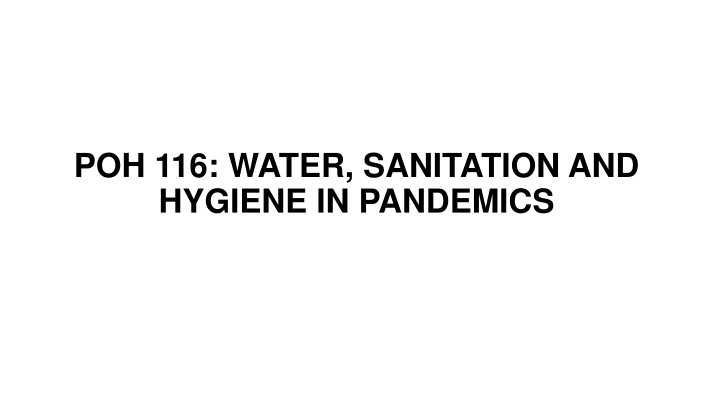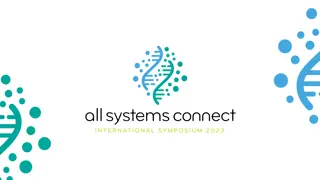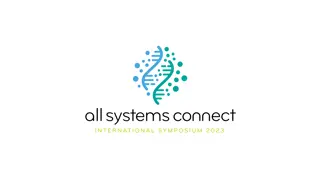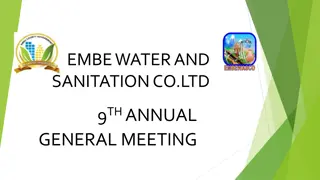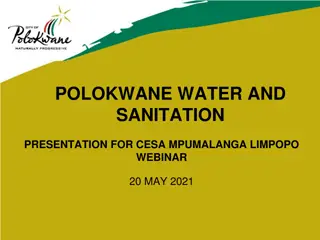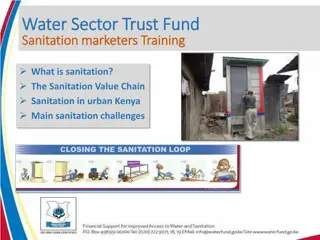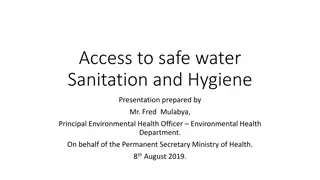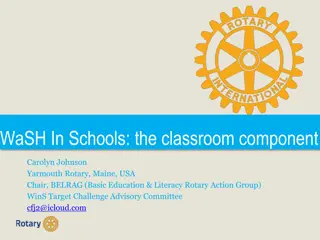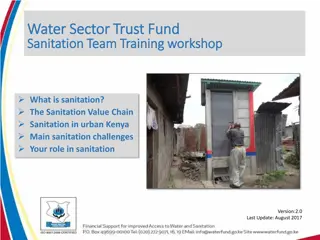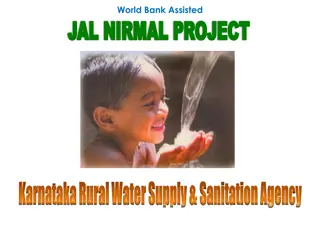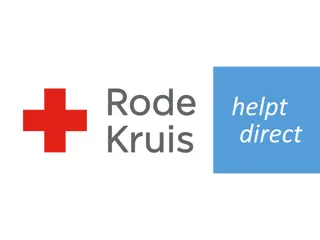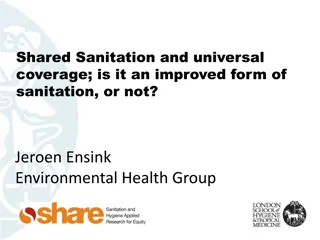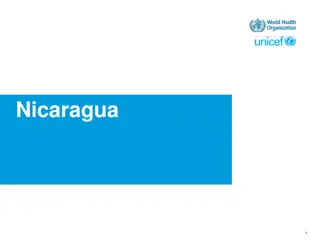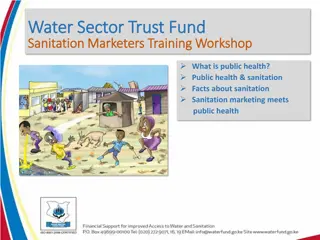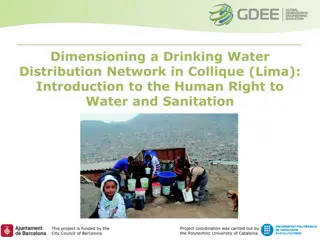Improving Water Quality, Sanitation, and Hygiene in Pandemics
This topic discusses the importance of Water, Sanitation, and Hygiene (WASH) in preventing emerging pandemics, emphasizing the One Health approach. Learners will explore WASH principles for disease control, gender roles in pandemic response, and how to utilize the One Health approach to address WASH-related disease outbreaks. The objective is to equip learners with the knowledge and skills to apply WASH principles effectively and respond to pandemics by improving water quality, sanitation, and hygiene practices.
Download Presentation

Please find below an Image/Link to download the presentation.
The content on the website is provided AS IS for your information and personal use only. It may not be sold, licensed, or shared on other websites without obtaining consent from the author.If you encounter any issues during the download, it is possible that the publisher has removed the file from their server.
You are allowed to download the files provided on this website for personal or commercial use, subject to the condition that they are used lawfully. All files are the property of their respective owners.
The content on the website is provided AS IS for your information and personal use only. It may not be sold, licensed, or shared on other websites without obtaining consent from the author.
E N D
Presentation Transcript
POH 116: WATER, SANITATION AND HYGIENE IN PANDEMICS
Purpose This topic will introduce learners to appropriate ways of improving water quality, sanitation and hygiene to prevent emerging pandemics threats using a One health approach.
Objectives This topic enables learning about: 1. The importance of WASH in preventing emerging pandemics 2. WASH principles for safe water, sanitation, and hygiene in disease control. 3. The One Health approach in preparing and responding to WASH-related disease outbreaks in households, populations. 4. Gender roles and responsibility in preparing and responding to WASH- related disease outbreaks. communities, and vulnerable
Expected Learning Outcomes At the end of the topic, learners should be able to: 1. Explain the importance of WASH in preventing emerging pandemics 2. Apply WASH principles to safe water, sanitation and hygiene to prepare and respond to pandemics 3. Utilize the One Health approach in preparing and responding to WASH-related disease outbreaks in households, communities and vulnerable populations 4. Describe the importance of gender roles and responsibility in preparing and responding to WASH-related disease outbreaks.
Definitions WASH is the combined term for Water, Sanitation, and Hygiene In 2010, the United Nations General Assembly explicitly recognized water and sanitation as human rights WASH is essential for the full enjoyment of life and all human rights
Definitions A pandemic is an outbreak of infectious disease that occurs over a wide geographical area and that is of high incidence and prevalence. Throughout history, there have been many deadly pandemics, such as the Black Death and the influenza pandemic of 1918 19. The COVID-19 outbreak was declared a pandemic in 2020 and killed millions of people. Pandemics can be caused by new strains or subtype of virus that first emerged in animals jumps to humans or by an existing disease-causing agent mutates, increasing its infectiousness or by antimicrobial resistance Pandemics typically slow down and come to an end on their own, though the process may be accelerated through effective preventive strategies, such as improved personal hygiene or the development of a vaccine.
Importance of WASH in Pandemics Water and sanitation are among the basic needs in epidemics and pandemics. Children and other vulnerable groups are susceptible to illness and death during epidemics Many infectious diseases are caused by lack of sanitation, inadequate safe water and poor hygiene. Risk of diarrheal diseases is high when there is poor access to WASH Access to WASH can accelerate socio-economic development. Access to adequate WASH facilities in households, communities and institutions is critical in disease prevention and response
Importance of WASH in Pandemics i. Promote healthy living for humans, animals and the environment ii. Prevent death from dehydration iii.Reduce the risk of water, sanitation, and hygiene-related diseases iv.Allow for adequate drinking, cooking, sanitation, personal and domestic hygienic requirements
WASH AND ONE HEALTH Journal of Water, Sanitation and Hygiene for Development. 2022;12(3):286-301. doi:10.2166/washdev.2022.204
The Sanitation Ladder The sanitation ladder is a useful tool that is being used to monitor progress towards the sanitation target of the SDGs The ladder aims at providing community members with a different sanitation information on a range of factors such as cost, convenience, upgradeability The ladder facilitates household and communal sanitation planning and decision making. Households can go up the ladder to reach the ideal improved latrine as last achievement Open defecation unimproved facility , to using a shared facility then an improved latrine. Households can go up the ladder to reach the ideal improved latrine as last achievement visual options, guide providing to upwards to use of a
Wash-related Diseases Water-borne diseases Caused by the ingestion of water, contaminated by human or animal faeces containing pathogens. Water-washed diseases Caused by inadequate or lack use of water for domestic and personal hygiene. Water-based diseases Infections caused by parasites usually found in aquatic organisms, for example schistosomiasis. Water-related diseases Insect vectors, breeding or living in or around water. The main cause of malaria. Diarrhoea, acute respiratory infection (pneumonia), and malaria Methods for managing WASH related diseases are interlinked, however they requires slightly different types of interventions that fall under the activities of the WASH.
Bradley Classification System for Water-related Diseases Category Example Diarrhoeal disease, cholera, dysentery, typhoid, infectious hepatitis Intervention Water-borne Improve drinking water quality, prevent causal use of unprotected sources Diarrhoeal disease, cholera, dysentery, trachoma, scabies, skin and eye infections, pneumonia Increase water quantity Improve hygiene Water-washed Reduce need for contact with contaminated water, reduce surface water contamination Water-based Schistosomiasis, guinea worm Improve surface water management, destroy insect breeding sites, use mosquito netting Water-related (insect vector) Malaria, onchocerciasis, dengue fever, Gambian sleeping sickness
Wash in Pandemics Two elements of WASH interventions in response to epidemics: i. Provision of Infection Prevention Control (IPC) measures in the health care facilities ii. An effective WASH outreach/hygiene promotion campaign in the community.
WASH Related Environmental Health Interventions in Pandemics i. Improving WASH infrastructure and services for water quantity and quality ii. Improving environmental sanitation including excreta disposal, vector control measures, etc. iii. Provision of household water treatment and hygiene kits, and iv. Conducting relevant campaigns on improving personal hygiene practices (on behaviors and practices that are risks related to the outbreak).
WASH and Gender in Pandemics Women are major stakeholders of WASH and during epidemics/pandemics. In most sub-Saharan African countries, adult women were primarily responsible for water collection in all the countries. Aside from the opportunity cost of time spent on water collection, women are at a higher risk contracting water-related diseases. There are safety and security risks for women and girls that are relevant to water and sanitation e.g. Women and girls have specific hygiene needs and need access to sanitary products so as to maintain menstruation hygiene. They are also prone to attacks when frequenting facilities that are far from the homestead To ensure success of health interventions , it is important to actively seek women s participation in water supply and sanitation programs at all stages Design of water and sanitation systems must consider gender analysis and equity.
WASH and Disabilities in Pandemics To ensure the success of health interventions , it is important to meet the needs of older people and people living with disability. It is important to have a clear understanding of the disabilities within the target population and consider specific needs of people with disabilities in terms of access and use of WASH facilities and services. There is need to build advocacy and support to policy development and capacity building of WASH professionals in recognizing and responding to the specific needs of people with disabilities. Customize toilets and washstands in schools and other public places to meet the wide range of needs of those with disabilities Key to inclusivity is to consult with people with disabilities in developing/designing WASH interventions
Water Supply - Access Humanitarian responders need to identify a source of water that can be used to provide the supply. They need to identify how much water each family needs to cover its basic drinking and domestic needs. Finally, they need to design appropriate ways to ensure that supply is provided in the most reliable manner possible. They need to work closely with the communities to ensure the solution proposed is acceptable and sustainable and to ensure that reliable drainage systems exist at all points of water use, re-using water where possible.
Key Indicators Used to Assess Water Access in Pandemics Average volume of water used for drinking and domestic hygiene per household: Maximum number of people using water-based facility: Percentage of household income used to buy water for drinking and domestic hygiene: Percentage of targeted households who know where and when they will next get their water:
Methods to Improve Water Access for Community Members in Pandemics Locating water points in areas that are accessible and safe for all, and especially women, children, older people, and people with disabilities. All users (incl. women, children, older people, and people with disabilities) should be fully informed of when and where water is available. Facilities should be central, accessible, and well-lit in order to contribute to the safety of users. Ensure that a minimum of 15 per cent of taps/water pumps are accessible and safe for people with physical, mobility-related and/or visual limitations. Make special arrangements at water points (e.g. separate queues) to avoid people with physical disabilities and older people having to stand and queue for long periods.
Water Supply - Quantity It is important to consider that the minimum amount of 15 liters of water/ person/ day (see the Sphere indicator showed earlier) is not appropriate in every context or phase of a response, as in pandemics: NEEDS QUANTITY (LITRES/P ERSON/DAY) ADAPT TO CONTEXT BASED ON... SURVIVAL: WATER INTAKE (DRINKING AND FOOD) Climate and individual physiology 2.5 - 3 Social and cultural norms HYGIENE PRACTICES 2 - 6 Food type and social and cultural norms BASIC COOKING 3 - 6 TOTAL BASIC WATER 7.5 - 15
Water Supply - Quality Faecal coliform bacteria indicate the level of human and animal waste contamination of water and the possibility of the presence of other harmful pathogens. If any faecal coliforms are present, then water must be treated to avoid deadfast spreading disease outbreak. Treatment can take place before distribution and/or at household level. Water can be tested for the presence of coliform forming units/ 100ml. If there is any identified, then it can be assumed the water is not safe to drink. If there is presence of free residual chlorine in the water, it suggests that the water has been treated and is therefore safe to drink.
Treatment Methods: At Household Level Household-Level Water treatment and Safe Water Storage methods i. Boiling. ii. Chlorination. iii. Solar disinfection. iv. Ceramic filtration. v. Sand filtration. vi. Membrane filtration Some considerations around Household-Level Water treatments: i. It is important to ensure that equipment and training is provided to community workers and the community themselves. ii. Ensure regular follow-up, support and monitoring to ensure these treatment methods are being implemented appropriately. iii. It is important to select appropriate household treatment based on water quality, local availability, and longevity.
Excreta Management - Access to and Use of Toilets Excreta disposal and management is one of the most important intervention during epidemics If not done properly, it can potentially cause a disease outbreak. Environment free from human excreta All excreta is safely contained onsite to avoid contamination of the natural, living, learning, working and communal environments There are no human faeces present in the environment near people. All excreta containment facilities are well sited and are an adequate distance from any surface or groundwater source. Access to and use of toilets People have adequate, and acceptable toilets to allow safe and secure access. Ratio of shared toilets (Minimum 1 per 20 people) Distance between dwelling and shared toilet (Maximum 50 metres) Percentage of toilets that have internal locks and adequate lighting.
Toilet means any facility or device that immediately and initially contains excreta and creates the first barrier between people and their waste. Toilet Type Detailed functions of the toilet Prevents open defecation but still holds significant health risks. often used as short-term solution at onset of an epidemics due to portability and quick set-up. Plastic Bag Prevents open defecation but still holds significant health risks. often used as short-term solution at onset of an epidemics due to portability and quick set-up. Bucket Hole in the ground, with concrete slab over the top and simple super structure. Does not use water. Only suitable where water table is low. Pit toilet Ventilated improved pit (VIP) toilet Improvements made to pit toilet which include ventilation pipe with wire mesh to prevent flies from entering the toilet. Improved pit toilet which uses water for flushing. Water seal to prevent odour and flies. Connected to twin pit or treatment units such as septic tanks or conventional sewer system. Pour flush toilet Elevated toilet Pit is elevated above ground. (Pour-flush and pit latrines can be elevated).
Hygiene Practices Around Animals Contact with animals has many positive effects for people. However, animals can carry harmful germs that make people sick even when the animal looks healthy and clean Germs that may be spread from animals to people include E. coli O157:H7, Salmonella, burnetii, Campylobacter, Yersinia enterocolitica, and ringworm. Cryptosporidium, Coxiella Rabies virus can spread rapidly especially when a rabid foxes or dogs bite humans or other animals
Principles of Hygiene Promotion All the work done regarding the design and construction of water supply and excreta management will be for nothing if the people using them do not manage them in a way that will ensure the barriers to infection are upheld. i. Target a small number of risk reduction practices. ii. Target specific audiences. iii. Identify the motives for changed behavior. iv. Use positive hygiene messages. v. Identify the best way to communicate. vi. Use a cost-effective mix of communication channels. vii. Carefully plan, execute, monitor and evaluate.
General Hygiene Always wash your hands with soap and water after handling animals and anything where they live or roam. This includes: After touching or playing with your pet After feeding your pet or handling pet food After handling pet habitats or equipment (such as cages, tanks, toys, and food and water dishes) After cleaning up after pets After leaving areas where animals live (such as coops, barns, and stalls), even if you did not touch an animal Before eating and drinking Before preparing food or drinks After removing soiled clothes or shoes Running water and soap are best for handwashing, but you can use hand sanitizer with at least 60% alcohol until running water and soap are available. Adults should supervise handwashing for young children.
Hygiene Promotion Implementation i. People are aware of key public health risks related to water, sanitation and hygiene, and can adopt individual, household and community measures to reduce them. ii. Appropriate items to support hygiene, health, dignity and well-being are available and used by the affected people. iii. Women and girls of menstruating age, and males and females with incontinence, have access to hygiene products and WASH facilities that support their dignity and wellbeing.
Integrated WASH and Activities for Improved Nutrition Outcomes Provision of hand washing and toilet facilities in the field and food processing facilities Behavior change on good hygiene practices around food preparation Reducing mycotoxins in food through controlled irrigation, moisture control, and through washing Reducing animal waste contamination
Integrated WASH and Activities for Improved Nutrition Outcomes Reducing chemical contamination Ensuring that irrigation runoff is not used for drinking water. Multiple use water systems Composting or ecosan for production of fertilizer Water retention for aquifer recovery sand dam construction Erosion control soil retention & flash flood mitigation Drip irrigation
References 1. 2. 3. 4. Sphere Association. The Sphere Handbook: Humanitarian Charter and Minimum Standards in Humanitarian Response, fourth edition, Geneva, Switzerland, 2018. www.spherestandards.org/handbook Bartram, J. Cairncross, and S. Hygiene, sanitation, and water: forgotten foundations of health. PLoS Med, vol. 7, 2010, e1000367. Blanchet, K. et al. An Evidence Review of Research on Health Interventions in Humanitarian Crises. LSHTM, Harvard School of Public Health, 2013. www.elrha.org Campbell, O.M. Benova, L. et al. Getting the basic rights: the role of water, sanitation and hygiene in maternal and reproductive health: a conceptual framework. Trop Med Int Health, vol. 20, 2015, pp. 252-67. Fewtrell, L. Kaufmann, et al. Water, sanitation, and hygiene interventions to reduce diarrhoea in less developed countries: a systematic review and meta-analysis. Lancet Infectious Diseases, vol. 5, 2005, pp. 42-52. www.thelancet.com Ministry of Health, (2013). Approaches to Health Care Waste Management, Health Workers Guide 2nd ed 5. 6. 7. 8.
Review of The Pandemic Preparedness with One Health approach (PPOH) short course is by the East African Community (EAC) Secretariat in cooperation with universities of the six EAC Partner States. It is facilitated by the German Government and implemented by the Deutsche Gesellschaft f r Internationale Zusammenarbeit GIZ GmbH through the Global Programme Pandemic Prevention and Response, One Health (GP PPOH)
